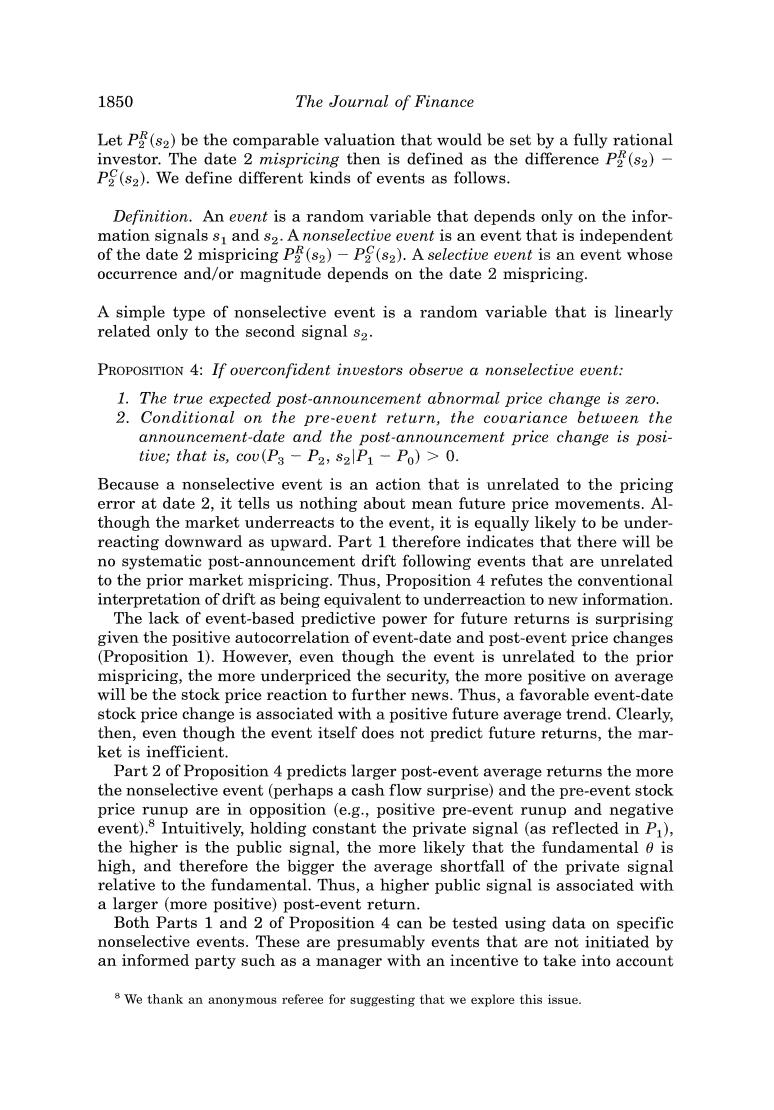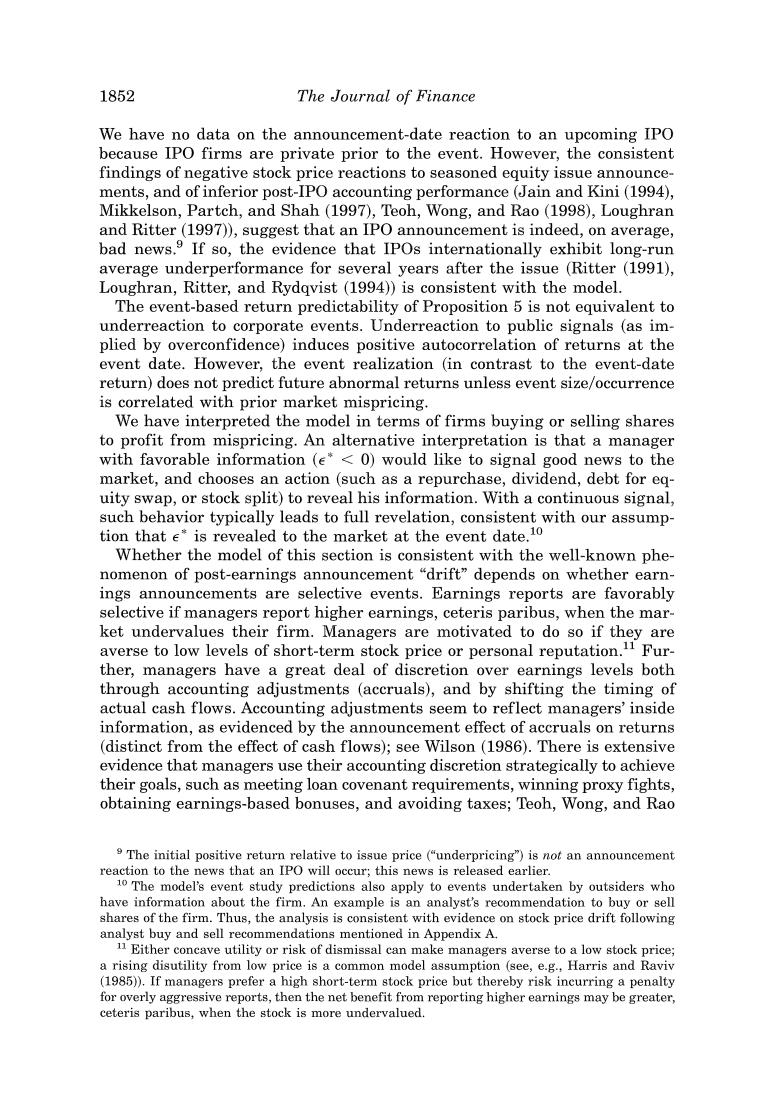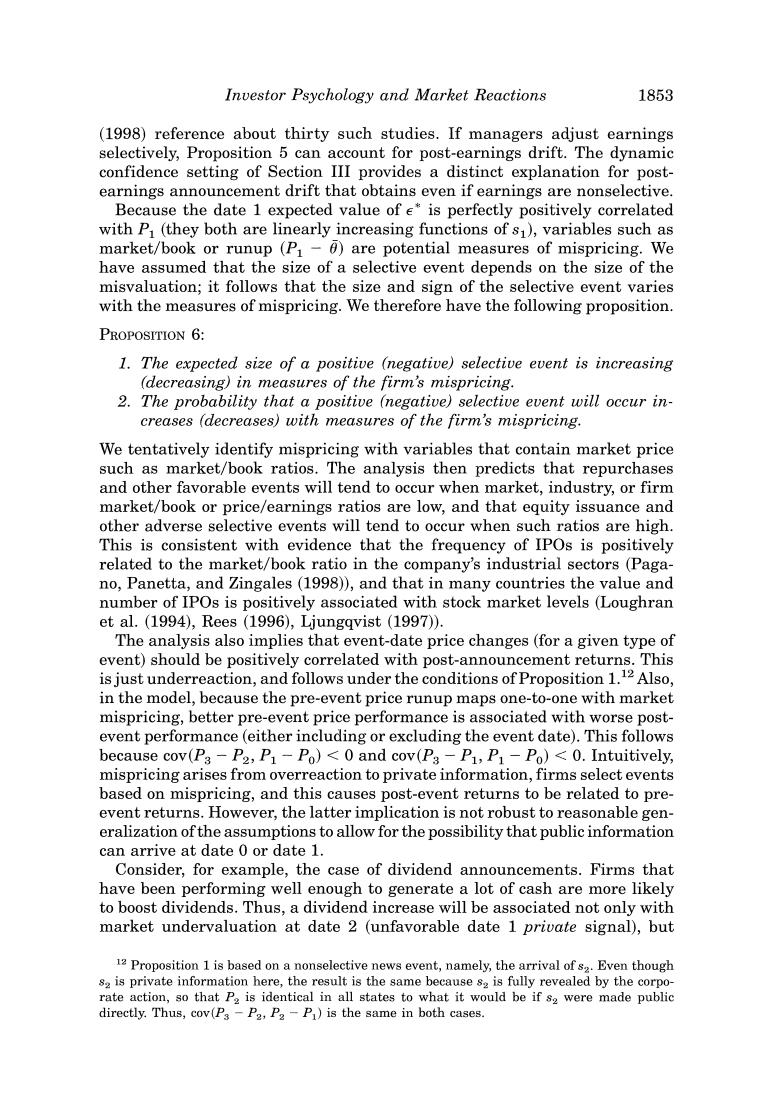
Investor Psychology and Market Reactions 1849 is therefore just the arithmetic mean of var(Pa-P2),var(P2-P1),and var(PI-Po).Excess volatility is the difference between the volatility with over- confidence and the volatility when the noise variance is perceived correctly. Let the subscript R denote the volatility if all individuals were rational. We define the date t proportional excess volatility as VE var(P.-P-1)-varg(P-P-1) (7) varR(P:-P:-1) PROPOSITION 3: 1.Overconfidence increases volatility around private signals,can increase or decrease volatility around public signals,and increases uncondi- tional volatility. 2.The proportional excess volatility is greater around the private signal than around the public signal. Thus,consistent with the findings of Odean (1998),when there are only private signals,there is a general tendency for overconfidence to create excess volatility.Excess volatility is not an automatic implication of any model with imperfect rationality.For example,if investors are underconfi- dent,od>2,then there will be insufficient volatility relative to the rational level.Also,in contrast to Odean,Proposition 3 implies that in samples broken down by types of news event,either excess or deficient volatility may be possible. B.3.Event Study Implications Many recent studies have investigated abnormal average return perfor- mance or "drift"following public news arrival.As mentioned in the intro- duction,a striking regularity in virtually all of these studies is that average post-event abnormal price trends are of the same sign as the average initial event-date reaction.We now slightly generalize the model to address this event-based return predictability. Sophisticated managers or analysts who are not overconfident are likely to selectively undertake certain visible actions,such as repurchasing shares or making buy recommendations,when a firm's shares are undervalued by the market.We will show that the nature of the stock price reaction to an event depends critically on whether or not the event is related to the mis- pricing by the market. We assume that the date 2 signal is no longer public,but is instead re- ceived privately by the firm's manager (or other individual such as an ana- lyst),and that this individual takes an action(the "event")that is publicly observed and fully reveals the signal.Let P(s2)be the valuation that would be placed on the security by an overconfident investor at date 2 were he to observe the signal s2 in addition to his signal s1.(Because we examine events that fully reveal s2,this is in equilibrium just the post-event stock price P2.)

1850 The Journal of Finance Let P(s2)be the comparable valuation that would be set by a fully rational investor.The date 2 mispricing then is defined as the difference P(s2)- P(s2).We define different kinds of events as follows. Definition.An event is a random variable that depends only on the infor- mation signals s and s2.A nonselective event is an event that is independent of the date 2 mispricing P(s2)-P(s2).A selective event is an event whose occurrence and/or magnitude depends on the date 2 mispricing. A simple type of nonselective event is a random variable that is linearly related only to the second signal s2. PROPOSITION 4:If overconfident investors observe a nonselective event: 1.The true expected post-announcement abnormal price change is zero. 2.Conditional on the pre-event return,the covariance between the announcement-date and the post-announcement price change is posi- tive;that is,cov(Ps-P2,s2 P1-Po)>0. Because a nonselective event is an action that is unrelated to the pricing error at date 2,it tells us nothing about mean future price movements.Al- though the market underreacts to the event,it is equally likely to be under- reacting downward as upward.Part 1 therefore indicates that there will be no systematic post-announcement drift following events that are unrelated to the prior market mispricing.Thus,Proposition 4 refutes the conventional interpretation of drift as being equivalent to underreaction to new information. The lack of event-based predictive power for future returns is surprising given the positive autocorrelation of event-date and post-event price changes (Proposition 1).However,even though the event is unrelated to the prior mispricing,the more underpriced the security,the more positive on average will be the stock price reaction to further news.Thus,a favorable event-date stock price change is associated with a positive future average trend.Clearly, then,even though the event itself does not predict future returns,the mar- ket is inefficient. Part 2 of Proposition 4 predicts larger post-event average returns the more the nonselective event(perhaps a cash flow surprise)and the pre-event stock price runup are in opposition (e.g.,positive pre-event runup and negative event).3 Intuitively,holding constant the private signal (as reflected in P1), the higher is the public signal,the more likely that the fundamental 0 is high,and therefore the bigger the average shortfall of the private signal relative to the fundamental.Thus,a higher public signal is associated with a larger (more positive)post-event return. Both Parts 1 and 2 of Proposition 4 can be tested using data on specific nonselective events.These are presumably events that are not initiated by an informed party such as a manager with an incentive to take into account a We thank an anonymous referee for suggesting that we explore this issue

Investor Psychology and Market Reactions 1851 mispricing.Such events might include news about product demand that em- anates from outside of the company (e.g,news about competitors'actions), or regulatory and legislative outcomes (e.g.,FDA decisions on drugs pro- posed by a pharmaceutical company). We now show that selective public events,that is,events that are corre- lated with pre-event stock mispricing,will forecast future price changes. Consider a manager who observes P(and therefore infers the private signal s1)and receives his own signal s2 at date 2.The manager can undertake a debt/equity exchange offering,and the attractiveness of a larger exchange depends on how high the market price is relative to fundamental value.He can condition the size of the offering on the mispricing at date 2,which he knows precisely,because he knows both s,and s2.It can easily be shown that in this setting the date 2 pricing error is proportional to the expected error in the private signal,e*=E[eP1,s2],where the expectation is again taken with respect to rational beliefs.For tractability,we consider selective events that are linear functions of the date 2 mispricing. When e*<0,the manager believes the market has undervalued the firm and that the firm can "profit"by exchanging debt for equity;the more un- dervalued the firm,the greater the size of the offering.Ife*>0,an equity- for-debt swap would be preferred instead.It is easy to show that E[P3-P2e*>0]<0<E[P3-P2le*<0]; (8) that is,events taken in response to market undervaluation(e.g.,repurchase) are associated with high post-event returns,and events taken in response to overvaluation (e.g.,new issue)are associated with low post-event returns. PROPOSITION 5:If investors are overconfident,then selective events that are initiated when the stock is undervalued (overvalued)by the market will on average be associated with positive (negative)announcement-date abnormal price changes and will on average be followed by positive (negative)post- announcement abnormal price changes. In Proposition 4 there was underreaction to news arrival but no post-event drift.Here,drift results from the combination of underreaction and event selection based on market mispricing.Thus,the model offers the new em- pirical implication that the phenomenon of abnormal post-event drift will be concentrated in events that select for market mispricing.Evidence recently brought to our attention supports this implication.Cornett,Mehran,and Tehranian(1998)find that involuntary issues undertaken by banks to meet capital requirements are not associated with postevent drift,whereas vol- untary bank issues are associated with negative post-event abnormal per- formance.Because involuntary issues are likely to be less selective than voluntary ones,this evidence is consistent with the model. If the announcement of an upcoming initial public offering (IPO),like a seasoned equity offering(SEO)announcement,reflects managers'"bad news," then Proposition 5 implies long-run underperformance following IPOs as well

1852 The Journal of Finance We have no data on the announcement-date reaction to an upcoming IPO because IPO firms are private prior to the event.However,the consistent findings of negative stock price reactions to seasoned equity issue announce- ments,and of inferior post-IPO accounting performance (Jain and Kini(1994), Mikkelson,Partch,and Shah (1997),Teoh,Wong,and Rao(1998),Loughran and Ritter(1997)),suggest that an IPO announcement is indeed,on average, bad news.9 If so,the evidence that IPOs internationally exhibit long-run average underperformance for several years after the issue (Ritter (1991), Loughran,Ritter,and Rydqvist (1994))is consistent with the model. The event-based return predictability of Proposition 5 is not equivalent to underreaction to corporate events.Underreaction to public signals(as im- plied by overconfidence)induces positive autocorrelation of returns at the event date.However,the event realization (in contrast to the event-date return)does not predict future abnormal returns unless event size/occurrence is correlated with prior market mispricing. We have interpreted the model in terms of firms buying or selling shares to profit from mispricing.An alternative interpretation is that a manager with favorable information (e*<0)would like to signal good news to the market,and chooses an action (such as a repurchase,dividend,debt for eg- uity swap,or stock split)to reveal his information.With a continuous signal, such behavior typically leads to full revelation,consistent with our assump- tion that e*is revealed to the market at the event date.10 Whether the model of this section is consistent with the well-known phe- nomenon of post-earnings announcement "drift"depends on whether earn- ings announcements are selective events.Earnings reports are favorably selective if managers report higher earnings,ceteris paribus,when the mar- ket undervalues their firm.Managers are motivated to do so if they are averse to low levels of short-term stock price or personal reputation.11 Fur- ther,managers have a great deal of discretion over earnings levels both through accounting adjustments (accruals),and by shifting the timing of actual cash flows.Accounting adjustments seem to reflect managers'inside information,as evidenced by the announcement effect of accruals on returns (distinct from the effect of cash flows);see Wilson(1986).There is extensive evidence that managers use their accounting discretion strategically to achieve their goals,such as meeting loan covenant requirements,winning proxy fights, obtaining earnings-based bonuses,and avoiding taxes;Teoh,Wong,and Rao s The initial positive return relative to issue price("underpricing")is not an announcement reaction to the news that an IPO will occur;this news is released earlier. 10 The model's event study predictions also apply to events undertaken by outsiders who have information about the firm.An example is an analyst's recommendation to buy or sell shares of the firm.Thus,the analysis is consistent with evidence on stock price drift following analyst buy and sell recommendations mentioned in Appendix A. 11 Either concave utility or risk of dismissal can make managers averse to a low stock price; a rising disutility from low price is a common model assumption (see,e.g.,Harris and Raviv (1985)).If managers prefer a high short-term stock price but thereby risk incurring a penalty for overly aggressive reports,then the net benefit from reporting higher earnings may be greater, ceteris paribus,when the stock is more undervalued

Investor Psychology and Market Reactions 1853 (1998)reference about thirty such studies.If managers adjust earnings selectively,Proposition 5 can account for post-earnings drift.The dynamic confidence setting of Section III provides a distinct explanation for post- earnings announcement drift that obtains even if earnings are nonselective Because the date 1 expected value of e*is perfectly positively correlated with PI(they both are linearly increasing functions of s1),variables such as market/book or runup (P-0)are potential measures of mispricing.We have assumed that the size of a selective event depends on the size of the misvaluation;it follows that the size and sign of the selective event varies with the measures of mispricing.We therefore have the following proposition. PROPOSITION 6: 1.The expected size of a positive (negative)selective event is increasing (decreasing)in measures of the firm's mispricing. 2.The probability that a positive (negative)selective event will occur in- creases (decreases)with measures of the firm's mispricing. We tentatively identify mispricing with variables that contain market price such as market/book ratios.The analysis then predicts that repurchases and other favorable events will tend to occur when market,industry,or firm market/book or price/earnings ratios are low,and that equity issuance and other adverse selective events will tend to occur when such ratios are high. This is consistent with evidence that the frequency of IPOs is positively related to the market/book ratio in the company's industrial sectors(Paga- no,Panetta,and Zingales(1998)),and that in many countries the value and number of IPOs is positively associated with stock market levels(Loughran et al.(1994),Rees (1996),Ljungqvist (1997)). The analysis also implies that event-date price changes(for a given type of event)should be positively correlated with post-announcement returns.This is just underreaction,and follows under the conditions of Proposition 1.12Also, in the model,because the pre-event price runup maps one-to-one with market mispricing,better pre-event price performance is associated with worse post- event performance (either including or excluding the event date).This follows because cov(P3-P2,P1-Po)<0 and cov(Ps-P1,P1-Po)<0.Intuitively, mispricing arises from overreaction to private information,firms select events based on mispricing,and this causes post-event returns to be related to pre- event returns.However,the latter implication is not robust to reasonable gen- eralization of the assumptions to allow for the possibility that public information can arrive at date 0 or date 1. Consider,for example,the case of dividend announcements.Firms that have been performing well enough to generate a lot of cash are more likely to boost dividends.Thus,a dividend increase will be associated not only with market undervaluation at date 2 (unfavorable date 1 private signal),but 12 Proposition 1 is based on a nonselective news event,namely,the arrival of s2.Even though sz is private information here,the result is the same because sz is fully revealed by the corpo- rate action,so that P2 is identical in all states to what it would be if s2 were made public directly.Thus,cov(P3-P2,P2-P)is the same in both cases